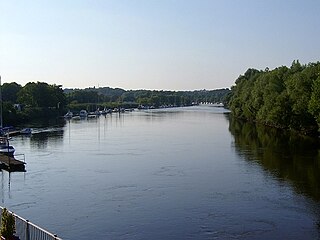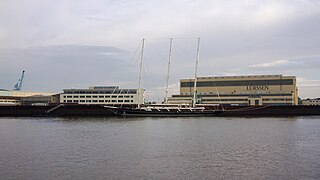
The Weser is a river of Lower Saxony in north-west Germany. It begins at Hannoversch Münden through the confluence of the Werra and Fulda. It passes through the Hanseatic city of Bremen. Its mouth is 50 km (31 mi) further north against the ports of Bremerhaven and Nordenham. The latter is on the Butjadingen Peninsula. It then merges into the North Sea via two highly saline, estuarine mouths.

Aktien-Gesellschaft "Weser" was one of the major German shipbuilding companies, located at the Weser River in Bremen. Founded in 1872 it was finally closed in 1983. All together, A.G. „Weser" built about 1,400 ships of different types, including many warships. A.G. „Weser" was the leading company in the Deutsche Schiff- und Maschinenbau AG, a cooperation of eight German shipbuilding companies between 1926 and 1945.

Bremen, officially the Free Hanseatic City of Bremen, is the smallest and least populous of Germany's 16 states. It is informally called Land Bremen, although the term is sometimes used in official contexts. The state consists of the city of Bremen and its seaport exclave, Bremerhaven, surrounded by the larger state of Lower Saxony in northern Germany.
Weser Flugzeugbau GmbH, known as Weserflug, was an aircraft manufacturing company in Germany.

The Lesum is a 9.85-kilometre-long (6 mi) river in northern Germany, right tributary of the Weser, navigable for Class III ships. It is formed at the confluence of the rivers Wümme and Hamme, near Ritterhude, northwest of Bremen. It flows west and flows into the Weser in Bremen-Vegesack.

The Hamme is a 48 km (30 mi) long river in Germany, Lower Saxony, north-east of Bremen. Its source is north of Osterholz-Scharmbeck. It flows through the moors north-east of Bremen called Teufelsmoor, and meets the river Wümme in Ritterhude. From this junction, the river is called Lesum. The Lesum flows into the river Weser in Bremen-Vegesack.

Lürssen is a German shipyard with headquarters in Bremen-Vegesack and shipbuilding facilities in Lemwerder, Berne and Bremen-Fähr-Lobbendorf.

Bremer Vulkan AG was a prominent German shipbuilding company located at the Weser river in Bremen-Vegesack. It was founded in 1893 and closed in 1997 because of financial problems and mismanagement.

Deutsche Schiff- und Maschinenbau Aktiengesellschaft was a cooperation of eight German shipyards in the period 1926 to 1945. The leading company was the shipyard AG Weser in Bremen.
Seebeckwerft A.G. was a German shipbuilding company, located in Bremerhaven at the mouth of the river Weser. Founded in 1876, it became later one of the leading shipbuilding companies in the region.

Bremen Switzerland is an undulating geest landscape in the north of Bremen and the adjacent district of Osterholz, and forms the western portion of the Osterholz Geest. In comparison to the rather flat land on which the city of Bremen is built and its surrounding area which is built on marsh and bog, Bremen Switzerland reaches heights of up to about 49 m above sea level (NN). The region of the Bremen Switzerland is framed by the Weser tributary of Lesum to the south, the Weser to the west, the marsh region of Osterstade to the northwest, the forest of Düngel to the north, the former B 6 federal route to Bremerhaven to the east and the adjoining heath of Lange Heide.
Vulkan is a cross-platform 3D graphics and computing API.

Schönebecker Aue is a geest stream in Bremen and Lower Saxony, Germany.

Jacob Ephraim Polzin was a German Neoclassical architect active in Bremen, Germany.

The Ports of Bremen, Bremen Ports or Bremish Ports, in German "Bremische Häfen" consist of the commercial ports in Bremen and Bremerhaven. They are managed by bremenports GmbH & Co. KG, a company of private status in public property.

German submarine U-1275 was a Type VIIC/41 U-boat of Nazi Germany's Kriegsmarine during World War II.
Joh. C. Tecklenborg was a German shipbuilding company, located at the river Geeste in Bremerhaven. About 440 ships of different types, including many famous tall sailing ships were built at the yard. Founded in 1841, it was finally closed in 1928.

Abeking & Rasmussen (A&R) is a shipyard situated in Lemwerder, near Bremen in the German state of Lower Saxony. The shipyard is on the left bank of the River Weser, and currently comprises five production halls with associated workshops and offices, an inner harbour and a syncrolift.
The Punkendeich was a dike (floodbank) between the river Weser and the city of Bremen that was known for prostitution. It ran from the city wall (Altenwall) to Sielwall. Originally called the Sieldeich, the Punkendeich was incorporated into the larger Osterdeich in 1850. A road and houses were built along the top of the dike, the road later becoming part of the Osterdeich trunk road.

Franz Ernst Schütte was a German entrepreneur-businessman who during his lifetime became celebrated for the extent of his wealth. Although his business activities extended across several different sectors, including shipbuilding and land reclamation-development, it was on account of his oil importing activities, which included the establishment of the "Deutsch-Amerikanische Petroleum Gesellschaft" in 1890, that Schütte acquired the popular soubriquet "The Petroleum King". In his home city Schütte is also remembered as a massively effective Bremen benefactor, both through his own donations and through his effectiveness as a fund raiser among fellow members of the city's business elite, during what was a period of unprecedented commercial expansion. The city owes its "new" city hall and its Botanical Gardens to his philanthropy, along with the rebuilding between 1888 and 1901 of the west end of Bremen Cathedral in the confident "Gothic revival" style favoured for prestigious public buildings in central and western Europe during this period.






















